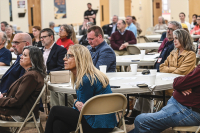A lone cry of reason from the wilderness
The January 2006 edition of “The Auk,” the journal of the American Ornithologists’ Union, includes a 15-page article by Jerome Jackson, an ornithologist and professor of biology at Florida Gulf Coast University questioning the conclusiveness of the evidence Cornell and partners submitted as proof positive of the existence of at least one ivory-billed woodpecker in the Cache river National Wildlife Refuge in Arkansas.
The Auk, in print since 1884, is highly respected in the birding world, and Jackson has some pretty hefty credentials. He is past president of the Wilson Ornithological Society, Mississippi Ornithological Society, Association of Field Ornithologists, and the Inland Bird Banding Association. He has served as editor of the Wilson Bulletin, Mississippi Kite, Journal of Field Ornithology as well as regional editor for American Birds and contributing editor of Birder’s World.
In 1985 he was appointed, along with James Tanner (the Cornell ornithologist who studied the last documented group of ivory-billed woodpeckers in the Singer Tract in Louisiana in the late 1930’s and early 1940’s), to the U.S. Fish and Wildlife Service’s Advisory Committee on the status of the ivory-billed woodpecker and conducted the last systematic search for the bird. Jackson’s piece in the Auk was in a section titled “Perspectives in Ornithology” and is a commentary not a scientific rebuttal. It is, however, meticulously referenced.
It’s important to keep in mind that Jackson never says the ivory-billed is extinct or that the Cornell team never saw one in the Cache River National Wildlife Refuge. He has said and is saying that the scientific evidence posited by Cornell and others falls short of definitive proof. Those are two very different precepts.
Jackson calls the announcement of the rediscovery of the ivory-billed woodpecker “faith-based ornithology.” He has stated unequivocally that he believes, along with Richard O. Prum of Yale and Mark B. Robbins of Kansas that the cornerstone of Cornell’s case – that four-second video – is simply a blurry, out of focus video of a pileated woodpecker.
The ivory-billed believers out there will not be swayed by Jackson’s article nor will they be swayed if May comes and there is still no ironclad evidence – they are believers. And that’s okay with Jackson. Remember, this article is not about the existence and/or extinction of the ivory-billed; it’s about Cornell’s search – the evidence and the implications of the “rediscovery.” It’s great reading for the open-minded. The easiest way to get to the article and attendant stories and reviews is to Google “Jackson Auk.”
Related Items
There is no doubt that he was “in the loop.” Much of his rationale is footnoted by personal communications with Cornell team members. What about those audio recordings that swayed Prum and Robbins?
“Scientists at Cornell University have acknowledged that these recorded vocalizations and double raps do not constitute evidence confirming the presence of Ivory-billed Woodpeckers” (Charif et al. 2005, Fitzpatrick et al. 2005a).
After the announcement of the rediscovery, much was made over $10 million of federal money that was going to aid the ivory-billed. Where did that money come from? “Announcement of the report of Ivory-billed Woodpeckers in Arkansas came with the spectacular news that $10.2 million had been allocated by the federal government for the recovery effort, $5 million from the Department of the Interior and $5.2 million from the Department of Agriculture (U.S. Fish and Wildlife Service 2005b). Then reality set in. Proposed expenditures for land acquisition and habitat protection are mostly a continuation of efforts under the North American Waterfowl Management Plan and by The Nature Conservancy that were already in progress when the presence of the Ivory-billed Woodpecker was reported (U.S. Fish and Wildlife Service 2005b; Allan Mueller, U.S. Fish and Wildlife Service, pers. comm.). In addition, the funding was not a new appropriation, but a re-allocation of funds from other budgeted projects, including ongoing efforts on behalf of other endangered species (Dalton 2005), resulting in cutbacks to those projects.”
Skeptics have talked since the announcement of the rediscovery about a population of aberrantly colored pileated woodpeckers in the Cache River National Wildlife Refuge, something Cornell has been most secretive about. In his paper Jackson writes, “I had seen several photographs of Pileated Woodpeckers with aberrant white on the wings and, indeed, within a week of the Ivory-billed Woodpecker announcement, I received such a photo from the U.S. Fish and Wildlife Service, the sender asking, “Why isn’t this an Ivory-bill?”
Jackson also worries if using the ivory-billed as poster-boy for conservation efforts might backfire. “What will happen two years from now,” he asks, “if researchers fail to provide unquestionable documentation of Ivory-billed Woodpeckers in the Big Woods? Will the public remember two years from now that the reports were ever made? Will conservation funding for the region be withdrawn? And what about the next time? Will those involved be so jaundiced by the experience that future reports of Ivory-billed Woodpeckers or other rare species will be ignored?”
This article is a great read.









